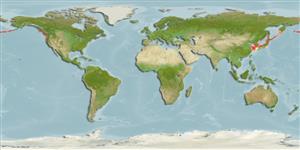Common names from other countries
Environment: milieu / climate zone / depth range / distribution range
Ekologi
laut dasar (demersal); oceanodromus (Ref. 51243); kisaran kedalaman 0 - 172 m (Ref. 114018). Temperate; 54°N - 30°N, 118°E - 118°W
Northwest Pacific: inland Sea of Japan to Kyushu, Japan. Northeast Pacific: From southern California to the western Aleutian Islands (Ref. 114018), Alaska (Ref. 11366).
Size / Weight / umur
Maturity: Lm ? range ? - ? cm
Max length : 15.0 cm SL jantan/; (Ref. 559); common length : 10.0 cm SL jantan/; (Ref. 559); Berat maksimum terpublikasi: 10.60 g (Ref. 112063); Umur maksimum dilaporkan: 3.00 Tahun (Ref. 125612)
deskripsi pendek
Kunci identifiaksi (pengenalan) | Morfologi | Morfometrik
Duri punggung (Keseluruhan (total)) : 0; duri punggung lunak (Keseluruhan (total)) : 55 - 59; Duri dubur: 0; Sirip dubur lunak: 28 - 32; vertebrata, bertulang belakang: 62 - 67. Characterized by having a horizontal skin fold along its ventral contour, and the absence of pelvic fin and teeth. Lateral plicae 160 to 180. Lower jaw pointed. Lateral line system on head not continuous with that on the body.
Found in sand bottoms and may enter semi-enclosed sea areas (Ref. 11230). Forms large schools. Important food fish in Japan (marketed fresh or dried) and marketed fresh but mainly used for meal and oil manufacture in Europe (Ref. 10384). Common size taken from picture in Ref. 559. Maximum size estimated as 1.5 * common size. Two genetically different lineages were found in Japan Sea/East Sea, perhaps representing two different species (J.K. Kim, oral.comm, FishBoL2012, June 2012).
Life cycle and mating behavior
Maturities | Reproduksi, perkembang biakan | Spawnings | Egg(s) | Fecundities | Larva
Masuda, H., K. Amaoka, C. Araga, T. Uyeno and T. Yoshino, 1984. The fishes of the Japanese Archipelago. Vol. 1. Tokai University Press, Tokyo, Japan. 437 p. (text). (Ref. 559)
Status IUCN Red List (Ref. 130435)
CITES (Ref. 128078)
Not Evaluated
ancaman kepada manusia
Harmless
penggunaan manusia
Perikanan: bernilai komersial tinggi
Alat, peralatan
Warning: mysqli::__construct(): (HY000/1040): Too many connections in /var/www/html/includes/speciessummary.lib.php on line 2104
Can't connect to MySQL database fbquizv2. Errorcode: Too many connections
